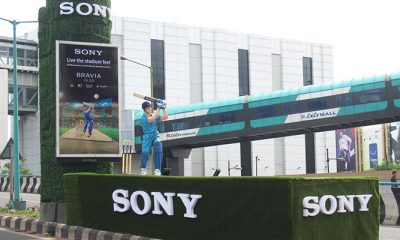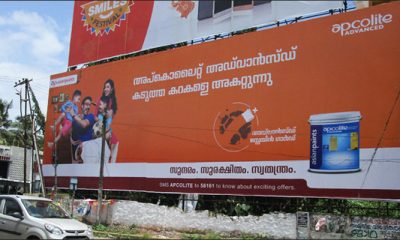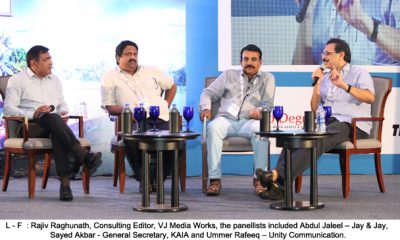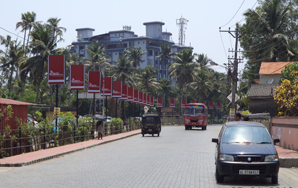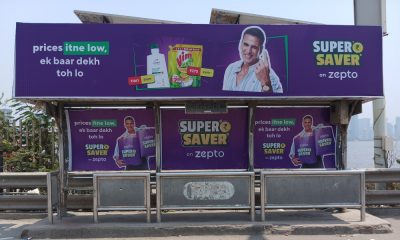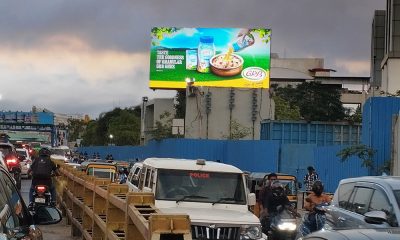Media Planning & Buying
Kerala OOH: Brimming with growth opportunities
Industry leaders believe that innovative media and improved monitoring systems will accelerate OOH business growth in the state
 The Kerala OOH market is growing at a reasonable pace, although it may not be comparable with some of the metro markets. Stating this, K Vijayakumar, Managing Director, Aiswaria Advertising, told Outdoor Asia that a greater number of brands across the country are targeting consumers in Kerala which will have a beneficial impact on the local OOH industry.
The Kerala OOH market is growing at a reasonable pace, although it may not be comparable with some of the metro markets. Stating this, K Vijayakumar, Managing Director, Aiswaria Advertising, told Outdoor Asia that a greater number of brands across the country are targeting consumers in Kerala which will have a beneficial impact on the local OOH industry.
Vijayakumar said the outdoor media in Kerala is a powerful vehicle for brands to deepen their consumer connect. He reckoned that Kochi is one of the most preferred markets for key outdoor advertising given that it is the commercial hub of the state. The city is also located in the mid-part of the state, so brands see it as a good entry point.
Vijayakumar said the media is becoming relatively costly but that has not come in the way of the industry’s growth. He felt that the northern part of the state is seeing faster growth in OOH business as new media formats and large hoardings have come up in the Malabar region.
Speaking about the different formats in demand, he said that street furniture like bus shelters and traffic signages at junctions are becoming popular with advertising brands. However, he felt that digital OOH has not made a mark in the state because it is being seen as a distraction for drivers on the road. Hence, permits for digital OOH media are not being given out so easily.
 Referring to some of the key challenges that the OOH industry faces in the state, Vijayakumar said that relatively high taxes imposes by the civic bodies and panchayats on OOH advertising is a big dampener on the business. He felt that the state government should also consider looking into the welfare of labour engaged by the OOH industry and provide them the same welfare schemes that are extended to factory labour, such as, group insurance, etc.
Referring to some of the key challenges that the OOH industry faces in the state, Vijayakumar said that relatively high taxes imposes by the civic bodies and panchayats on OOH advertising is a big dampener on the business. He felt that the state government should also consider looking into the welfare of labour engaged by the OOH industry and provide them the same welfare schemes that are extended to factory labour, such as, group insurance, etc.
Vijayakumar echoed the KAIA plea for rationalising the taxes levied on outdoor business in the state. High taxes are cutting into the profitability of the OOH media owning firms, leaving them little room to reinvest in the business.
Vijayakumar opined that the fragmented nature of outdoor business in Kerala is also hurting the industry as intensive competition is exerting extreme margin pressure on the players.
On a different tack, he said that “creativity is largely missing in the industry. Unless new and innovative media are introduced in the market, brands will not sustain their interest in outdoor advertising. But, there is a downside risk to experimentation. Some companies introduced transit media properties a few years ago, but their initiatives ran aground. Yet, he asserted that innovative media is key to sustaining the industry’s growth over the long term.
 He added that Kerala OOH market is not seasonal, like many OOH markets around the country. “There is business even during the rainy season.
He added that Kerala OOH market is not seasonal, like many OOH markets around the country. “There is business even during the rainy season.
Sebastian, Director, Time Ads, said that while the OOH industry in the state is currently faced with challenges like lack of a robust monitoring mechanism or absence of new OOH formats, the scenario will change dramatically in the coming years. Referring to the Metro project that is underway in Kochi, he said that such rapid transport systems will create a new raft of OOH business opportunities in the state.
Sebastian added that efforts are underway to introduce better OOH monitoring and measurement systems in the state. However, it appears that this would be largely driven by individual companies until the time when a common OOH currency is developed and promoted across the country.
Sebastian said that Kerala OOH will also give higher ROI in the coming times and added that quality brands are entering the Kerala OOH fray. Luxury brands like Jaguar, Mercedes Benz, and BMW have advertised in Kerala.
Commenting on the business prospects for digital OOH, Sebastian said that investments will not be a show-stopper. Rather, the Government norms pertaining to digital OOH have stymied this segment’s growth. However, he said categorically that “the future rests with digital OOH.
 When asked about the new growth centres in the state, he said that markets like Thrissur are growing fast. “In fact, Thrissur has almost become a part of the Kochi market now with improved road connectivity between the two centres, he said.
When asked about the new growth centres in the state, he said that markets like Thrissur are growing fast. “In fact, Thrissur has almost become a part of the Kochi market now with improved road connectivity between the two centres, he said.
Commenting on the dynamic character of the OOH industry in the state, Rajesh Kumar of Chitra Painters said that NRI remittances ensure that the household disposable incomes are high. “Hence, brands are easily drawn to this market, he said, adding that advertisers also find the prevailing rate very reasonable.
However, Rajesh Kumar added that the Kerala OOH industry does not get a fair share of the OOH budgets of large brands. Agencies tend to divert budgets apportioned for Kerala to other metros, and they treat Kerala as a single city. “When clients approach the Kerala OOH directly, they are seen to spend more. he said.
Rajesh Kumar felt that the Kerala’s media owning firms “need to adopt best practices, which will greatly augment advertisers’ confidence in the medium. He said that as KAIA is currently working out an SOP for the industry, there is a clear expectation that the industry as a whole will pursue standard practices. “There are no written rules regarding media owners’ obligation vis-Ã -vis campaign execution. The SOP will ensure that the rights of all stakeholders are protected, he added.
 Sharing his views on the prospects of digital OOH in the state, he said that not many would be prepared for the high investments that this medium entails. “Digital OOH calls for heavy investments which may not be covered with the current rates. There are low quality DOOH properties in Kerala but that may not appeal to advertisers. Also, Kerala faces frequent power cuts, so DOOH may not deliver the goods, he observed. “Visibility is a key factor for OOH success. If the power problem is not sorted, digital OOH will not work.
Sharing his views on the prospects of digital OOH in the state, he said that not many would be prepared for the high investments that this medium entails. “Digital OOH calls for heavy investments which may not be covered with the current rates. There are low quality DOOH properties in Kerala but that may not appeal to advertisers. Also, Kerala faces frequent power cuts, so DOOH may not deliver the goods, he observed. “Visibility is a key factor for OOH success. If the power problem is not sorted, digital OOH will not work.
Referring to transit media opportunities, Rajesh Kumar said that the current taxation norms are hurting transit media like moving media. Apparently, a single day’s display attracts a whole year’s road tax. Besides, there are issues like getting prior approval from the RTO. “Overall, the Government is not helping this industry to grow, he said.
Chitra Painters is one of the oldest outdoor outfits in the state, and perhaps around the country. It was founded in 1960. At that time, “landlords were willing to pay for putting up hoardings on their site, he said, saying it was a prestige then to have a billboard on their own land. Rajesh Kumar works closely with his brother Chitra Prakash who is the Managing Partner of the firm.
Commenting on the current trends in the Kerala OOH industry, Dany Antony, Managing Director, Zero Degree, said that new formats like unipoles are getting a good response from advertisers. He pointed out that Kochi is the main OOH market in the state but the ongoing Metro rail construction has gravely affected OOH business in the city. Some 500 hoardings have been pulled down for the Metro work to progress, and this has undermined the business of many media owners. However, once the project is completed, new OOH properties would be created, such as, pillar branding opportunities, inside Metro advertising, station advertising, and so on.
Antony said that bus shelter advertising is picking up in the state. Lamp post advertising and median advertising are the other growing segments.
Speaking about some of the challenges in the market, he said that rising land rentals are affecting the margins of media owners. He also pointed out that major advertising categories like jewellery and textile showrooms are facing new business challenges which could affect their OOH spends too.
Antony said that national brands are increasing their presence on the Kerala OOH landscape. They are fanning out to all parts of the state. Talking about the most promising markets within Kerala, he said that Kochi tops the list, followed by Thiruvananthapuram, Thrissur and Kozhikode. Thrissur has one of the highest occupancy rates.
Abdul Jaleel, Managing Director, Jay n Jay, told Outdoor Asia that Kozhikode is one of the most dynamic OOH markets in the state considering that it accounts for the entire Malabar region. Moreover, the local brands that advertise on OOH opt for long duration campaigns that range from 6 months to 1 year. Jaleel said that key local advertising categories are jewellery, textiles, footwear traders.
Hoardings make up the bulk of OOH media in Kozhikode, as is the case with rest of Kerala, but Jaleel said there is potential for other formats to take deep roots in this region.
The optimism exuded by the Kerala OOH leaders suggest that growth is here to stay.
-

 Campaigns
CampaignsBurger King’s DOOH innovation for Korean Spicy Fest
-
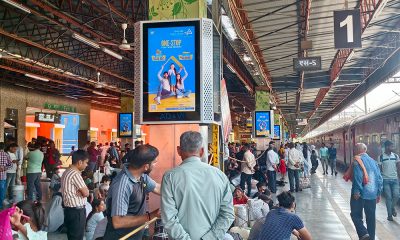
 Digital Network
Digital NetworkAD&VI DOOH network inaugurated at Anand Vihar Railway Terminal
-

 OOH Industry
OOH IndustryData-driven media buying: Lessons from Jun Sakurai on Japan’s OOH evolution
-
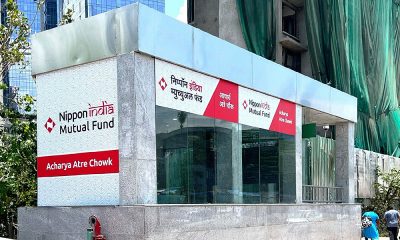
 OOH Industry
OOH IndustryNippon India Mutual Fund acquires station branding rights for Acharya Atre Station on Mumbai Metro Line 3.
